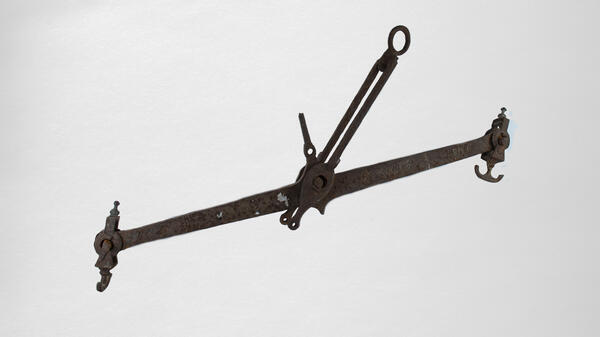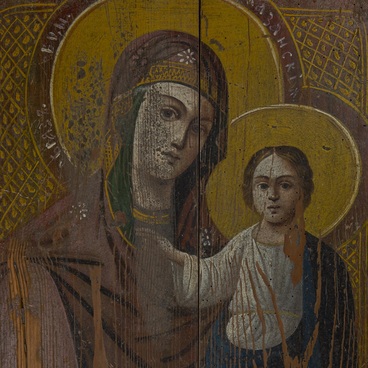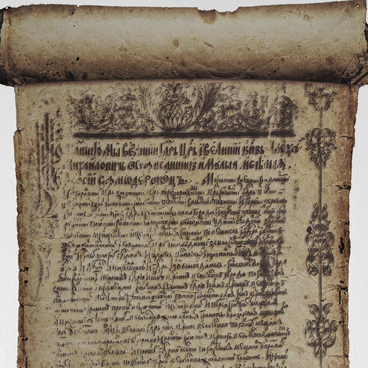In the town of Pogar, large fairs were held three times every year: on both of the Saint Nicholas Days also known as “Nikola Letny” and “Nikola Zimny”, as well as on the feast of the Dormition of the Mother of God. Merchants from Little Russia, Great Russia, Konigsberg, and Riga gathered there. The preparatory days before the fairs were called “podtorzha”: merchants delivered goods and built small wooden shops, and residents dressed up and sang songs. Fairs lasted from two to three weeks. They sold hemp oil, wheat, rye, salo (cured slabs of fatback, rarely pork belly), honey and other agricultural products, as well as glassware.
The Pogar merchants participated in the other cities’ fairs. Specifically, they grew hemp, made fiber out of the hemp stems, and traded in Kyiv, Nezhyn, Glukhov, and Krolevets. In addition, this fiber was delivered to the Western European countries through the St. Petersburg and Riga ports, as well as the Rzhev and Poretsk wharves further to the east. For the wholesale trade, merchants used big scales — “kantyr”. Most commonly, the scales were used to weigh berkovts and pryadyva, being the alternative name for hemp fabric (stem fiber) in Pogar. It was produced from hemp stems. The stems were beaten, and then the derived hempen mass underwent retting in the flowing water. The hemp fibers featured durability and resistance to saltwater; therefore, they were often used in the marine fleet. Hemp ropes and cables are currently employed, due to their almost everlasting wear if it comes in contact with sea salt.
Back in the day, the weight measure “berkovets” was called “berkovesk” or “björkö”. This name came from the old Swedish trading city of Björkö. This is an old unit of weight, equal to 10 puds, or 160 kilograms. Initially, it was used for weighing tobacco, hemp, and other cargo bales. Therefore, such bundles were also called berkovets. The berkovets was first mentioned in the Charters of Novgorod by Knyazh Vsevolod Mstislavich. Besides the Novgorod chronicles references, the berkovets was also mentioned in the Pskov literary texts.
In the museum collection dedicated to the Magdeburg law, one can see the big scales — “kantyr”. It features a cast inscription,
The Pogar merchants participated in the other cities’ fairs. Specifically, they grew hemp, made fiber out of the hemp stems, and traded in Kyiv, Nezhyn, Glukhov, and Krolevets. In addition, this fiber was delivered to the Western European countries through the St. Petersburg and Riga ports, as well as the Rzhev and Poretsk wharves further to the east. For the wholesale trade, merchants used big scales — “kantyr”. Most commonly, the scales were used to weigh berkovts and pryadyva, being the alternative name for hemp fabric (stem fiber) in Pogar. It was produced from hemp stems. The stems were beaten, and then the derived hempen mass underwent retting in the flowing water. The hemp fibers featured durability and resistance to saltwater; therefore, they were often used in the marine fleet. Hemp ropes and cables are currently employed, due to their almost everlasting wear if it comes in contact with sea salt.
Back in the day, the weight measure “berkovets” was called “berkovesk” or “björkö”. This name came from the old Swedish trading city of Björkö. This is an old unit of weight, equal to 10 puds, or 160 kilograms. Initially, it was used for weighing tobacco, hemp, and other cargo bales. Therefore, such bundles were also called berkovets. The berkovets was first mentioned in the Charters of Novgorod by Knyazh Vsevolod Mstislavich. Besides the Novgorod chronicles references, the berkovets was also mentioned in the Pskov literary texts.
In the museum collection dedicated to the Magdeburg law, one can see the big scales — “kantyr”. It features a cast inscription,



